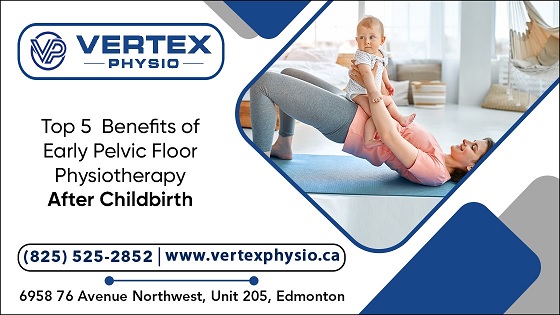Childbirth is a transformative experience that can significantly impact a woman’s physical health, particularly the pelvic floor muscles. Early intervention with pelvic floor physiotherapy Edmonton after childbirth is highly recommended to support recovery and prevent long-term complications. This, also known as postnatal physiotherapy, focuses on strengthening and rehabilitating the pelvic muscles that may be weakened or damaged during delivery. Engaging in female pelvic floor physiotherapy soon after childbirth provides a foundation for better postpartum recovery, enhancing a mother’s physical well-being and her ability to care for her newborn.
1. Faster Recovery from Birth-Related Strain
Enhanced Healing
Childbirth can significantly strain and stretch the pelvic muscles and tissues, sometimes leading to prolonged discomfort and a slower return to daily activities. Early initiation of pelvic floor physiotherapy after delivery is crucial for new mothers. It accelerates the rehabilitation process by stimulating blood flow to the affected area, which enhances tissue healing and reduces inflammation. Starting pelvic floor exercises under the guidance of a specialist in pelvic floor physiotherapy in Edmonton can help strengthen these muscles, enhancing the body’s natural healing processes. This reduces the likelihood of lingering discomfort and promotes a quicker recovery, enabling new mothers to resume their pre-pregnancy lifestyle more rapidly.
2. Prevention of Urinary Incontinence
Improved Bladder Control
Urinary incontinence is a prevalent issue among postpartum women, characterized by involuntary urine leakage, which can happen during coughing, sneezing, laughing, or exercising. This condition is often due to the weakening of the pelvic floor muscles during childbirth. Early pelvic floor physiotherapy involves specific exercises designed to strengthen these muscles, providing better bladder support and improving bladder control. By engaging in targeted pelvic floor exercises soon after childbirth, women can significantly reduce the risk and severity of postpartum urinary incontinence, which contributes to improved confidence and quality of life.
3. Reduction in Pelvic Pain
Alleviation of Discomfort
Many women experience significant pelvic pain after childbirth, which can stem from factors such as nerve damage, muscle strain, and tissue trauma. This discomfort can be exacerbated by weakened pelvic muscles that cannot support the pelvic organs effectively. Engaging in pelvic floor physiotherapy shortly after delivery can be instrumental in alleviating this pain. Through a regimen of carefully curated exercises, these therapies strengthen the pelvic muscles and enhance the stability of the pelvic region. As these muscles become stronger and more supportive, pelvic pain decreases, thus enhancing postpartum recovery and comfort.
4. Improved Sexual Health
Restoration of Sexual Function
Childbirth can result in pelvic floor damage, which may lead to complications in sexual health, such as discomfort during intercourse and reduced sensation. Pelvic floor physiotherapy is crucial in addressing these issues by restoring muscle tone in the pelvic floor muscles. Through targeted exercises and treatments, this therapy enhances the strength and flexibility of these muscles, leading to improved control and reduced discomfort. Additionally, pelvic floor physiotherapy increases blood flow to the pelvic area, further aiding in the healing process and enhancing tissue sensitivity. As a result, women can experience an improvement in sexual health and satisfaction, helping them regain a fulfilling sexual life post-childbirth.
5. Prevention of Prolapse
Support for Pelvic Organs
Pelvic organ prolapse, where pelvic organs like the bladder, uterus, or rectum drop due to weakened support muscles, is a condition that can significantly affect postpartum women. This often occurs when the pelvic floor muscles are overstretched or torn during childbirth, leading to reduced support for these organs. Engaging in pelvic floor physiotherapy soon after delivery can significantly mitigate this risk. This therapy strengthens the pelvic floor muscles, effectively providing the necessary support to hold pelvic organs properly. By enhancing the strength and integrity of these muscles, pelvic floor physiotherapy helps prevent the onset of prolapse symptoms, such as a feeling of heaviness or bulging in the pelvic area. It contributes to a more stable and supported pelvic structure.
Exercises for Postpartum Recovery and Pelvic Health
Pelvic Tilts
This exercise involves lying flat with knees bent, tightening the abdominal muscles, and tilting the pelvis. It enhances healing by strengthening the abdominal and pelvic floor muscles, facilitating faster recovery from birth-related strain.
Kegel Exercises
Kegel exercises focus on contracting and holding the pelvic floor muscles, similar to controlling urine flow. These exercises are crucial for improving bladder control and preventing urinary incontinence postpartum.
Bridging
It is performed by lying on the back, raising the hips to make a line from knees to shoulders, and then slowly lowering. Bridging is beneficial for reducing pelvic pain by strengthening the lower back and pelvic muscles.
Squats
Squats involve standing feet apart, lowering the body into a squat, and returning to stand. They help restore muscle tone and blood flow to the pelvic area, improving sexual health and overall pelvic muscle strength.
Leg Lifts
Leg lifts involve lying on one side and lifting the top leg about 12 inches, holding it briefly, then lowering it back down. This exercise supports the pelvic organs and helps prevent prolapse by strengthening the muscles around the pelvic area.
Postpartum women can significantly enhance pelvic muscle strength and functionality by incorporating these exercises into their rehabilitation program. Engaging in pelvic floor physiotherapy in Edmonton soon after childbirth can lead to a better quality of life and enhanced postnatal recovery.
Securing Postpartum Recovery Through Pelvic Floor Physiotherapy
In summary, the benefits of initiating pelvic floor physiotherapy early after childbirth are clear and impactful. At Vertex Physiotherapy, specialized programs in pelvic health physiotherapy are designed to assist new mothers in recovering strength and stability in their pelvic region, which is crucial after the rigours of childbirth.
Engaging in pelvic floor physiotherapy in Edmonton can provide significant benefits, including improved pelvic health and overall well-being for mothers looking to enhance their postpartum recovery. If you are a new mother, consider contacting Vertex Physiotherapy to discuss how pelvic floor physiotherapy can be integrated into your postpartum care. Take proactive steps to ensure your recovery is as smooth as possible.
Read more: The Great Running Debate: Treadmill vs. Outdoor – Which Wins?

